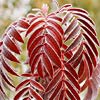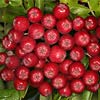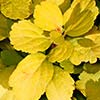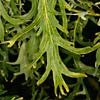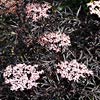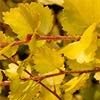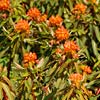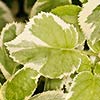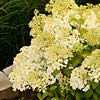
Polish historical varieties of decorative trees
We are pleased to present you Polish historical varieties of decorative trees. They have common history and origin: all of them have been selected, described and introduced to cultivation in Polish nurseries. Many of them have been considered lost for years. Thanks to years of efforts of people with passion some of these interesting and precious plants were found. It is worth to remember about this valuable fragment of the Polish horticultural heritage.
We owe majority of the presented varieties to the famous breeder – Feliks Rożyński. He was managing Nurseries in Podzamcze in the manor of the Zamoyski family.
Our Nursery has been actively searching for old Polish varities for years. We find them, reproduce and start their production.
The following varieties, due to their origin and traditions related thereto, are especially recommended to historical parks and gardens.
We owe majority of the presented varieties to the famous breeder – Feliks Rożyński. He was managing Nurseries in Podzamcze in the manor of the Zamoyski family.
Our Nursery has been actively searching for old Polish varities for years. We find them, reproduce and start their production.
The following varieties, due to their origin and traditions related thereto, are especially recommended to historical parks and gardens.
Acer pseudoplatanus 'Foliis Atropurpureis Argenteovariegatis'
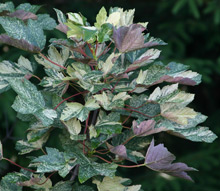 Dark green irregularly white and cream variegated leaves, with significantly larger light spots, pink purple on the bottom surface. The variety grows slower than the species. Recommended to large bakyard gardens and parks, where it looks good while planted as a solitary plant.
Dark green irregularly white and cream variegated leaves, with significantly larger light spots, pink purple on the bottom surface. The variety grows slower than the species. Recommended to large bakyard gardens and parks, where it looks good while planted as a solitary plant.The variety was named, described and introduced to trading in 1909 by Feliks Rożyński. It was cultivated in Nurseries in Podzamcze until 1913.
Alnus incana 'Foliis Aureomarginatis'
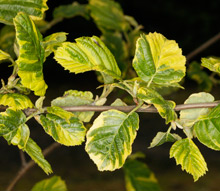 Leaves with irregularly yellow variegated margins constitute the most significant decorative element of the plant. Characteristic feature of the variety is slower growth than in the case of the species and complete frost hardiness.
Leaves with irregularly yellow variegated margins constitute the most significant decorative element of the plant. Characteristic feature of the variety is slower growth than in the case of the species and complete frost hardiness.
The variety is recommended to parks and larger backyard gardens. It looks perfect while planted nearby water reservoirs or as a single tree on lawns or meadows. It can be composed with other species and varieties.
Betula 'Hoseri'
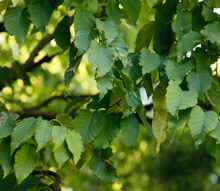 Variety with characteristic brown bark. It has elongated (up to 14 cm long), sharply-pointed leaves that beautifully change their color to yellow in autumn.
Variety with characteristic brown bark. It has elongated (up to 14 cm long), sharply-pointed leaves that beautifully change their color to yellow in autumn. This high tree is recommended to large backyard gardens and parks, as a single tree or in compositions with other trees or high shrubs.
Carpinus betulus 'Foliis Argenteovariegatis Pendula'
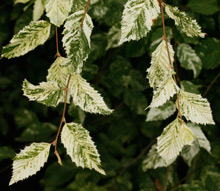 Low-growing, up to 6-8 m high tree with characteristic wide columnar, slightly pendant habit. Irregularly white variegated leaves constitute the most significant decorative element. The variety is completely frost hardy.
Low-growing, up to 6-8 m high tree with characteristic wide columnar, slightly pendant habit. Irregularly white variegated leaves constitute the most significant decorative element. The variety is completely frost hardy.This variety is recommended to average size and large backyard gardens and parks. It can be planted as a single tree or in color groups as an element that brightens the composition. It is recommended to cut the tree regularly in order to have it constantly produce new shoots with beautifully colored leaves.
Fraxinus pennsylvanica 'Crispa'
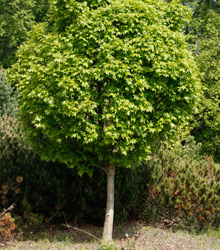 Variety with dense round habit and thick slightly curled and wavy-margined leaves. Crown up to 3-6 m in diameter. This variety is usually grafted on high trunks. Completely frost hardy.
Variety with dense round habit and thick slightly curled and wavy-margined leaves. Crown up to 3-6 m in diameter. This variety is usually grafted on high trunks. Completely frost hardy. This variety is recommended to parks and gardens as an alley tree or to be planted separately on lawns or flower beds.
Fraxinus pennsylvanica 'Crispa' was introduced to trading by Feliks Rożyński in nurseries of the Zamoyski family in Podzamcze in 1904.
Picea abies 'Krasickiana'
Variety with pendant habit. It has long pendant branches that make the tree look majestic. Recommended to large backyard gardens and parks. Looks best while planted as a solitary plant. Trees look particularly attractive while planted nearby water reservoirs when their weeping silhouette reflects in water.
Picea pungens 'Compacta Pyramidalis'
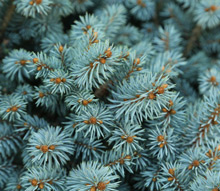 Dwarfish variety with conical habit and slow growth. Initially it creates a dense shrub. It produces leader over time. Old trees are conical, very dense but irregular. Lateral branches are slightly pendant. Up to 2-3.5 m high and 0.8-1 m in diameter. Short blue grey needles with wax coating. Does not bear cones.
Dwarfish variety with conical habit and slow growth. Initially it creates a dense shrub. It produces leader over time. Old trees are conical, very dense but irregular. Lateral branches are slightly pendant. Up to 2-3.5 m high and 0.8-1 m in diameter. Short blue grey needles with wax coating. Does not bear cones.Quercus robur 'Jan Zamoyski'
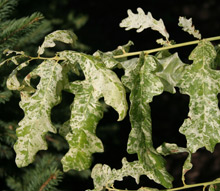 This beautiful Polish variety of Quercus robur grows up to 8-10 m high. Leaves on secondary shoots – very long (even up to 25 cm long) and intensely white and cream variegated leaves, constitute the most significant decorative element. Bark of the shoots is olive green and cream yellow on the young and secondary shoots. The plant is completely frost hardy.
This beautiful Polish variety of Quercus robur grows up to 8-10 m high. Leaves on secondary shoots – very long (even up to 25 cm long) and intensely white and cream variegated leaves, constitute the most significant decorative element. Bark of the shoots is olive green and cream yellow on the young and secondary shoots. The plant is completely frost hardy.
Robinia pseudoacacia 'Karolina Zamoyska'
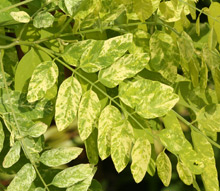 The variety has lemon yellow or light green yellow variegated leaves. Th eleaves become darker and the variegation lightens up and finally becomes white over time. Interesting is the fact that the leaves change their colors best when the plant is cultivated in shadow or partial shadow areas. Completely frost hardy; its growth does not diverge from the one of the species.
The variety has lemon yellow or light green yellow variegated leaves. Th eleaves become darker and the variegation lightens up and finally becomes white over time. Interesting is the fact that the leaves change their colors best when the plant is cultivated in shadow or partial shadow areas. Completely frost hardy; its growth does not diverge from the one of the species.
Robinia pseudoacacia 'Rozynskiana'
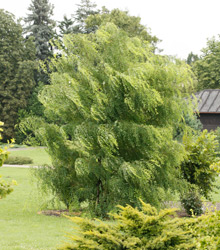 Large up to 20 m high tree with original look. It has long (up to 50 cm long) pendant leaves, collected in sparsely distributed leaves. Because of these atypical leaves the tree has pendant weeping habit. Completely frost hardy variety.
Large up to 20 m high tree with original look. It has long (up to 50 cm long) pendant leaves, collected in sparsely distributed leaves. Because of these atypical leaves the tree has pendant weeping habit. Completely frost hardy variety. Robinia pseudoacacia 'Rozynskiana' was bred by Feliks Rożyński in nurseries of Andrzej Zamoyski in Podzamcze before 1896. It was not reproduced or planted after the war. Thanks to efforts of Włodzimierz Seneta, it was found and again introduced to cultivation in 1990s.






